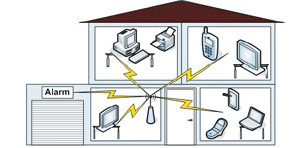| 2005 |

|
YEAR BOOK |
Dublin City University
|
High-Quality Prioritised Services over Wireless Home Area Network
|

As the number of supported services grows and some of them such as the multimedia-based ones have high bandwidth requirements, the limited WHAN network capacity is put under pressure. Moreover there are other performance issues when transmitting data over wireless networks such as low delivery rates (e.g. theoretically up to 11 Mbps for IEEE 802.11b and up to 54 Mbps for IEEE 802.11g although only half that in practice) and high error rates due to media characteristics, contention, signal attenuation with distance, signal interference, etc. Therefore variations in quality of service are expected in time and in loaded network conditions some may trigger users' dissatisfaction.
In order to increase the overall quality of services delivered over WHAN, a novel adaptive approach based on user-assigned priorities is being investigated. The adaptive solution relies on the fact that a controlled reduction in quality is preferred to the severe effect random loss and extremely variable or large delays have on these services. The prioritised adaptive scheme involves temporary decreases in the transmitted quality of some lower priority streams if they use shared resources inefficiently, allowing higher priority streams to take advantage of the resources available. This solution not only makes the whole system benefit in terms of overall quality of service, but also enables the users to select those services and/or devices they are more interested in to avail of higher priority and consequently better quality in difficult delivery conditions.
Contact: Dr. Gabriel-Miro Muntean, School of Electronic Engineering,
Dublin City University, Glasnevin, Dublin 9;
Tel: 01 700 7648; E-mail: [email protected] Web: http://www.eeng.dcu.ie/~munteang